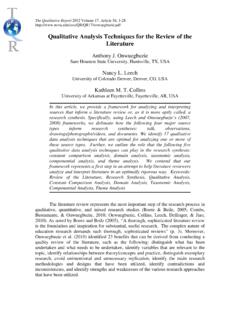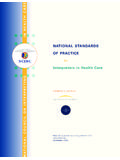Transcription of Analyzing and Interpreting Findings - SAGE Publications Inc
1 5 Analyzing andInterpreting FindingsOVERVIEWQ ualitative research begins with questions,and its ultimate purpose is learning. To informthe questions, the researcher collects are like building blocks that, whengrouped into patterns, become information,which in turn, when applied or used, becomesknowledge(Rossman & Rallis, 2003). Thechallenge of qualitative analysis lies in mak-ing sense of large amounts of data reducingraw data, identifying what is significant, andconstructing a framework for communicat-ing the essence of what the data reveal.
2 Thiswas the task of chapter 4. The challenge nowbecomes one of digging into the Findings todevelop some understanding of what liesbeneath them; that is, what information wenow have and what this really , in this sense, is about deconstruct-ing the Findings an essentially goal in conducting analysis is to fig-ure out the deeper meaning of what you havefound, and that analysis began when youassigned codes to chunks of raw data. Nowthat you have a well-laid-out set of Findings ,you go to a second level. You scrutinize whatyou have found in the hope of discoveringwhat it means or, more precisely, whatmeaning you can make of it.
3 You are seekingways to understand what you have foundby comparing your Findings both within andacross groups, and by comparing yourstudy s Findings with those of other qualitative research, we are open to dif-ferent ways of seeing the world. We makeassumptions about how things work. We striveto be open to the reality of others and under-stand different realities. We must listen beforewe can understand. Analysis of the findingsbegins with careful listening to what othershave to say. Begin by asking yourself: Givenwhat I have found, what does this mean?
4 Whatdoes this tell me about the phenomenon understudy? What is really going on here? In askingthese questions, you are working back andforth between the Findings of your researchand your own perspectives and understandingsto make sense and meaning. Meaning cancome from looking at differences and similari-ties, from inquiring into and interpretingcauses, consequences, and analysis in qualitative research remainssomewhat mysterious (Marshall & Rossman,2006; Merriam, 1998). The problem lies in thefact that there are few agreed-on canons forqualitative analysis in the sense of sharedground rules.
5 There are no formulas for deter-mining the significance of Findings or for inter-preting them, and there are no ways of perfectlyreplicating a researcher s analytical thinking. Inthis chapter, we do not purport to offer arecipe, but rather some guidance for 12/26/2007 11:59 AM Page 127the analytical process. Applying guidelinesrequires judgment, sensibility, and each study is unique, each analyticalapproach used is unique as well. As Patton(2002) puts it: In short, no absolute rules existexcept perhaps this: Do your very best withyour full intellect to fairly represent the dataand communicate what the data reveal giventhe purpose of the study (p.)
6 432). Indeed,because qualitative research depends on theskills, training, capabilities, and insights of theresearcher, qualitative analysis and interpreta-tion ultimately depends on the analytical intel-lect and style of each individual with all previous chapters, we present twosections: Section I, Instruction, talks about (a) thinking about, (b) planning, and (c) pre-senting your analysis. Section II, Application, presents what an analysis chapter might looklike. By using the example carried throughoutthis book, we analyze and interpret the findingsof the research that we have must be stressed that Analyzing andinterpreting are highly intuitive processes;they are certainly not mechanical or techni-cal.
7 The process of qualitative data analysisand synthesis is an ongoing one, involvingcontinual reflection about the Findings andasking analytical questions. As such, there isno clear and accepted single set of conven-tions for the analysis and interpretation ofqualitative data. Indeed many qualitativeresearchers would resist this were it to comeabout, viewing the enterprise as more an artthan a science. Therefore, the term instruc-tionsfor this chapter might be somewhatmisleading. Reducing the data and present-ing Findings can be explained in a stepwiseand somewhat mechanical fashion.
8 Analysis,synthesis, and interpretation of qualitativedata, in contrast, is a far more nebulousendeavor hence the clear paucity of pub-lished literature on how to actually do it (andhence the limited annotated bibliographythat we offer for this section). Rather thaninstructions, what we provide in this chapterare essentially guidelines for how to thinkabout analysis and principles to use in select-ing appropriate procedures that will organi-cally unfold and become revealed as youbecome immersed in your own be aware too that the guidelines andprinciples that we provide are essentiallygeneric and can be applicable across a broadrange of qualitative genres or traditions.
9 Eachtradition is sensitive to particular analyticalmethods and strategies. As such, each traditionrequires that the researcher think about analy-sis in a particular way. For more details andnuances regarding analysis for pure qualitativetraditions such as phenomenology, groundedtheory, ethnography, and hermeneutics, wesuggest that you consult with your advisor andalso seek the relevant available literaturerelated to your specific OBJECTIVESC hapter 5 ObjectivesSection I: Instruction Explain the concept of qualitativeanalysis.
10 Explain how to analyze andinterpret the Findings of yourresearch. Explain the concept of synthesis asan ongoing process. Describe how to go about presentinga final II: Application Presentation of a completed analysisand interpretation chapter based onthe content and process as previous chapter discussed how topresent the Findings of your research byCOMPLETING YOUR QUALITATIVE 12/26/2007 11:59 AM Page 128organizing data from various sources into cat-egories to produce a readable narrative. Thepurpose of this chapter is to provide interpre-tative insights into these Findings .

















